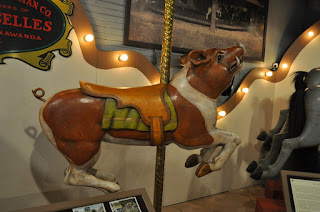The first horses were made entirely of wood, but the more recent ones are half wood, and half aluminum casts. The carvers were just factory workers, and they weren't allowed to sign their work. This makes it very difficult to find out exactly who made each horse. The animals have hollow bodies however, and on the inside of one ostrich there was a signature secretly inscribed by the carver.
The carousel figures were not only limited to horses, they included many other animals also. On display at the museum is a pig, dog, rooster, and more. More exotic animals such as zebras and giraffes might also be found on a carousel.
Another interesting aspect of the animals is the contrast between the two sides. The side that is facing outwards from the carousel (which everyone will see) is much more detailed, with many small decorations. The opposite side (facing inward) is very simple. There are no decorations, with just an outline of a saddle. This saves time and materials in making the animals, and the difference is usually not noticeable by passersby.
Here is a picture that is on display at the museum of a carousel full of many different species of animals.

The carousels have more than just animals to ride on, they also have chariots. The chariots are stationary on the carousel and do not move up and down like the animals. They are made in a wide variety of designs such as the dragon pictured left or the woman in colorful waves pictured below.
The last type of seat on the carousel would be the spinning Lover's Tub (pictured below). This is hand powered by the passenger, who can control the spinning of the seat by the pole in the middle. The decorations on the Lover's Tub are usually flowers and nature scenes.









No comments:
Post a Comment